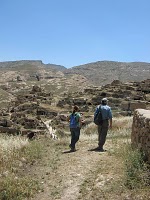Sunday,
May 23, 2010
(note, the original post was removed for awhile; we are reposting this blog on an important topic that has still not been resolved in July 2012)
Hasankeyf
(37°42'N;
41°24'E)
is
an ancient city carved into the rocky bluffs along the Tigris River.
The site has been continuously occupied for more than 10,000 years,
and its setting among rolling hills and sheer cliffs along the river
is breathtakingly beautiful. The town is threatened by plans to build
the Ilisu Dam on the Tigris River, creating a massive reservoir that
would drown all but the highest sections of Hasankeyf, along with 200
other villages, displacing at least 80,000 people.
 |
| Hasankeyf could be submerged to the height of the Mosque tower |
It
was sunny and warm the day of our visit with guide Ipek Tasli, the
local coordinator for the Initiative to Keep Hasankeyf Alive, part of
a a coalition of 72 groups which includes municipalities,
environmental organizations, and “chambers of commerce”
(www.hasankeyfgirisimi.com).
She took that position two years ago, though the group formed in 1997
(the idea for a dam on the Tigris River has been around for decades.)
 Hasankeyf
may be one of the oldest continuously inhabited places on Earth. An
article in Smithsonian
magazine
in March 2009, noted Hasankeyf's role as a commercial center along
the Silk Road trade route from China during the early Middle Ages:
“Marco
Polo likely passed over its once-majestic stone, brick and wooden
bridge, built around 1116 (only two massive stone piers and one arch
remain).” From the newer bridge, we hiked uphill to where thousands
of caves had been cut into limestone cliffs and used as residences
and churches. A hilltop fortress included a secret stairway cut
inside the cliff to maintain access to the river water during a
siege.
Hasankeyf
may be one of the oldest continuously inhabited places on Earth. An
article in Smithsonian
magazine
in March 2009, noted Hasankeyf's role as a commercial center along
the Silk Road trade route from China during the early Middle Ages:
“Marco
Polo likely passed over its once-majestic stone, brick and wooden
bridge, built around 1116 (only two massive stone piers and one arch
remain).” From the newer bridge, we hiked uphill to where thousands
of caves had been cut into limestone cliffs and used as residences
and churches. A hilltop fortress included a secret stairway cut
inside the cliff to maintain access to the river water during a
siege.
Returning
to the riverside for a meal of barbecued fish, we watched as people
played in the river shallows and young adults danced and sang in the
street. There was a national holiday that day. We ate our Tigris
River fish, seated around a low table on divans built right against
the river edge, where we could watch fish down in the current
nibbling at our crumbs.

International
attention and resistance to the Ilisu dam project has grown because
the reservoir will flood such extremely important historical and
archaeological sites. Swiss, German, and Austrian underwriters within
the European Union had funded initial work on the dam, but pulled out
in December 2008 after so many issues emerged. A list of 150 World
Bank conditions dealing with the environment, protection of heritage
sites, relocation of residents, and impacts on Iraq, downstream,
would have to be addressed if they were to provide funding. Turkey,
however, is moving ahead with projected completion in 2017. The
government vows it will fund the construction on its own. Ipek's
coalition wonders what outside money is making that possible and the
local Kurdish population is wary that this is part of on-going
pressure against the region's Kurdish communities and culture.

The
Tigris River here creates a unique canyon/riparian ecosystem. Fishing
has been a major part of the human economy and also farming. With a
dam, the fish populations will change and the river ecosystem will be
gone. A local soft-shelled turtle (Rafetus
euphraticus)
has become a symbol of the environmental impacts for the Turkish
environmental group, Doga Dernegi, which maintains an information
booth within the town of Hasankeyf (www.dogadernegi.org).
The turtle used to be found along the Euphrates also, but is nearly
gone there now because so many dams have been completed. The effects
of Ilisu could bring the species to the brink of extinction. But
Turkey has no Endangered Species Act, nor, apparently, a public trust
doctrine on which to rely for legal protection. Perhaps it would help
if Turkey was accepted into the European Union, which has more
progressive environmental laws.
Ipek,
though only 25 years old, is very eloquent and knowledgeable. We
asked her what she hopes to see happen, and she answered that they
will do their best to lobby internationally to, hopefully, bring
pressure on the Turkish government. She said, “Hasankeyf does not
belong to Turkey, it belongs to humankind. We will ask the people of
the world to save Hasankeyf.”
Should
an ancient city that is part of the history of humankind be
sacrificed for more electricity and water reservoirs? The
eyes of the world need to turn toward Hasankeyf.






